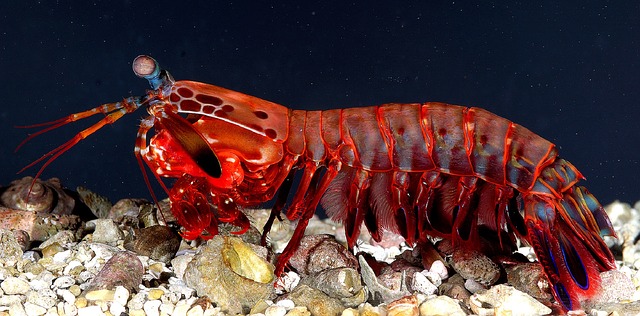The colorful mantis shrimp has been elevated to high-technology status as scientists used the crustacean’s one-of-a-kind features to create new, super strong materials.
The mantis shrimp has the ability to smash the shells of other creatures using a fist-like limb called a dactyl club. In a new study from the University of California, Riverside and Purdue University, scientists found that this dactyl club had a very unique herringbone that protected the club as it impacted, allowing the mantis shrimp to cause a lot of damage.
This concept has paved the way for the development of materials that can be used for armor, cars, aircraft, helmets and many more items that will have extremely high levels of power and strength.
Mantis shrimps fall into two categories: smashers and spearers. Spearers beat their prey with a spear, while smashers use speed and force to pound the shells of prey like crabs and snails. In 2012, a study was released detailing the dactyl club used by smashers, which has inspired modern industries to begin work on real products based on this.
In the 2012 study, the researchers found that the dactyl club has many regions. The periodic region, found in the internal part of the dactyl club, absorbs energy and sorts shear waves, which pass through materials when under stress. The first stage of the periodic region is an organic phase made of chitin, a substance found in animal shells, arranged in a spiral staircase pattern. The second stage is an inorganic phase made of amorphous calcium phosphate and calcium carbonate.
This new research has found a new region in the outer portion of the dactyl club: a herringbone structure called the impact region. This is a crack-resistant part of the club that protects the mantis shrimp. It is composed of crystalline calcium phosphate, which is also present in human bones. These minerals surround organic chitin fibers, which were pressed into a herringbone that is harder than that on the periodic region. This is what allows the mantis shrimp to inflict such deadly damage on its prey by using a higher momentum upon contact.
The team also found that the outermost layer of the impact region has another thin covering of the dactyl club. This layer decreases stress that may possibly lead to club failure.
Nicholas Yaraghi, lead author on the study, says this is the first time the unique herringbone has been studied in nature.
The researchers conducted element investigations to determine what the different structures of the dactyl club do. They also made a 3D print of the herringbone structure for analysis, and created computational models that show the features of the herringbone structure. Using these models, they were able to explain how the impact region is more efficient when it comes to equalizing stress and preventing breaks.
“While the computational modeling results gave us compelling confirmation of the redistribution of stresses in these structures, the ‘wow’ moment came when we tested our 3D printing samples,” co-author Nicolas Guarin-Zapata said.
This new discovery is valuable information into the team’s ongoing efforts to develop new super strong materials that can be used for any number of applications.
The study was published in the journal Advanced Materials.
























